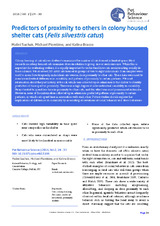Predictors of proximity to others in colony housed shelter cats (Felis silvestris catus)
Autor
Suchak, Malini
Piombino, Michael
Bracco, Kalina
Editor
Universidad de Córdoba, Departamento de Medicina y Cirugía AnimalFecha
2016Materia
CatsColony housing
Felis catus
Multi-cat household
Proximity
Shelters
METS:
Mostrar el registro METSPREMIS:
Mostrar el registro PREMISMetadatos
Mostrar el registro completo del ítemResumen
Colony housing of cats allows shelters to maximize the number of cats housed in limited space. Most research on colony-housed cats examines stress in relation to group size or enclosure size. While this is important for evaluating welfare, it is equally important to understand how cats are interacting socially in these colonies. We observed 259 adult cats housed in groups of two to eight individuals. Scan samples were used to assess how frequently individual cats were in close proximity to other cats. These data were used to measure individual differences in sociability and patterns of proximity to certain partners. We used information about the past history of the cat, which was collected upon admission to the shelter to identify predictors of time spent in proximity. There was a high degree of inter-individual variability in sociability. Strays tended to spend less time in proximity to other cats, and this effect was most pronounced in females. However, none of the information collected upon admission predicted patterns of proximity to certain partners, or which cats spent time in association with each other. Future studies should explore the implications of differences in sociability by associating observations of social behavior and stress behaviors.

